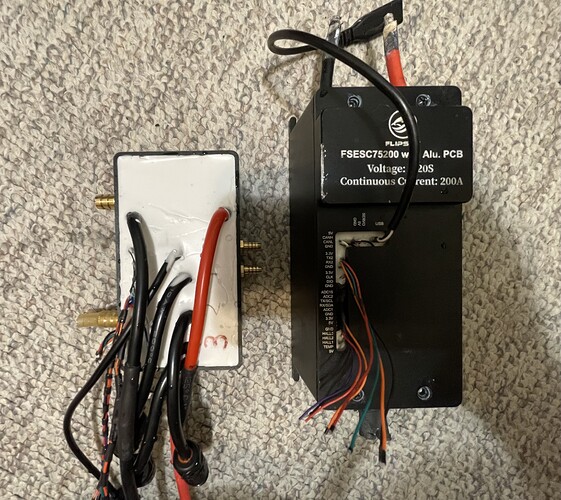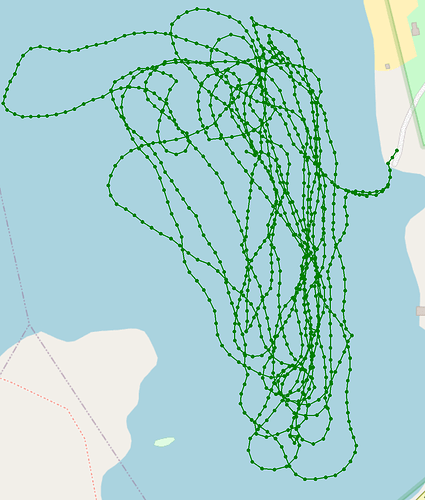I’ve had the same thoughts about the 65161 motor. Heavy and seems to be more power than necessary for me. There may be some good in running the motor well below its limits.
On my next build I am thinking of trying a smaller 65121 motor. The small outrunners can also work, but I’ve read they can be noisier and one feature I love with eFoil is how quiet it can be when the wind is at your back cruising over the water
Yes the 65121 looks good almost half the weight. With the 65161 I am usually running at 20% throttle around a 1000 watts on the foil so the the 121 would be plenty for foiling maybe a bit longer to start. The reduce weight would be nice.
Just note that 65121 seems to be on the limit for torque, judging by the builds i’ve seen here.
Either smaller prop/higher speed, low weight rider or a low drag board seems to be needed for guaranteed takeoff.
Once you are up the numbers are pretty negligible. Its the acceleration and take off power requirement that is important. Then another factors to consider is also how aggressively someone rides. During hard carves you can use a lot of power.
I would rather have the big 161 and operate in mid power range instead of pushing a small motor to it’s limit. Im 100kg
It also depends on the board size and the foil of your setup. Small boards and small wings need more power to get you on the foil. weather conditions also have an influence on the power you need. It is harder to launch in choppy water than on a flat surface. Board size is probably the biggest factor. As a reference, with my 100l 160cm inflatable and a 63100 motor I can takeoff in almost all conditions apart from choppy waves > 0.5m.
Final prices of the build:
-
Motor Flipsky 65161 120KV, Round shaft with thread - $200.00 + $30 shipping from Ebay
-
VESC Flipsky 75200 water cooled - $90 from China
-
Remote Flipsky VX3 - $73 from Amazon
-
Propeller Fliteboard - $25 + $10 shipping from Electricsurf
-
Batteries 60V 32Ah - $300 from Facebook
-
Foil Naish MA 1600 - $475 from Facebook
-
Board Inflatable AZTRON FALCON AIR X - $290 + $60 shipping from OutdoorXL
-
Wires, connectors, waterproof cases, etc… - ~$30
Total: $1583
Weight of the build in kg:
Board 6.715
Ropes 0.135
Battery 11.04
Esc 1.125
Mast + Motor 4.725
Foil 2.715
Total 26.455
Are there any experiences with a smaller motor?
For my built I’d like to have just a relaxed cruising speed, with a 120l board, an big beginner foil and 80 kg rider, so I’m also looking for a smaller motor .
Not yet, but I plan to test a smaller motor and ESC. I’m choosing between a 6384 motor with an FS 75100 ESC and a motor with an integrated ESC.
I have not really started my next build yet, later this year when the weather gets cold.
There are plenty of eFoil builds that have used the 6384 motors, it’s probably a safer choice compared to a 65121 if you want something small. I’m about 62kg and I usually use under 2kW to take off, so I think I can get away with the weaker 65121, but I have no experience with it yet.
Thoughts on the 65111?
Had a super long day today! Charged the battery to 87% and rode for 2 hours and 45 minutes. Ended with the battery at 28%. Now I’ve got some serious foil skills and can ride for ages without crashing. So tired but got tons of data!
Here’s what I learned: max power use is 1400W at 23A against strong winds and 1250W at 20A without wind. For cruising, I’m usually at 1000W and 17A.
Swapped my ESC from a 75200 to a much smaller 75100.
Not sure why everyone recommends more powerful ESCs. Maybe they have smaller boards and foils. I could probably go even smaller, like a 7550, since my big board and foil need less power to glide and take off.
My water cooling broke, so I rode without it. Max MOSFET temp hit 38°C when my prop and foil got tangled in weeds, pulling max current of 40A. Normally, temps stayed between 30-36°C and dropped to 27°C when I landed on water. So, turns out I don’t need water cooling on a water-cooled ESC in a waterproof case because it’s massive and dissipates heat well on its own. Plus, the ESC doesn’t generate much heat at that current.
A lot depends on your weight too. I assume you are relatively light for that current and power.
Yup, with the board, the total weight is around 100 kg.
If the total weight was doubled to 200 kg, the current could be around 50A, right?
Because of startup requirements and speed requirements.
No, not how it works at all. At 200kg that board would be a lot harder to get on the plane and you’d need a lot more thrust which means you’d probably need around 200A give or take.
Also the size of foil makes a massive difference.
You are running 16S which means less current while many tend to run around 12S so need extra current.
A friend of mine recently tested his assembly with a 65111 motor and a standard propeller, and he was unable to get on the foil. Its weight is 95 kg. He gave it to his daughter, who is half the weight, to test it, and she almost succeeded. He plans to experiment with propeller and wing sizes. In addition, its battery pack is located under the board on the mast, which makes movement difficult. In general, it is difficult to say for sure whether 65111 is suitable.
The stock propeller is mid. The Fliteboard prop slaps way harder.
Well, one more argument against 65111: 12 awg wires were installed on it. According to the specification, they can carry a maximum of 30 Amps. The 65121 is equipped with 8 awg wires, the same as the 65161.

